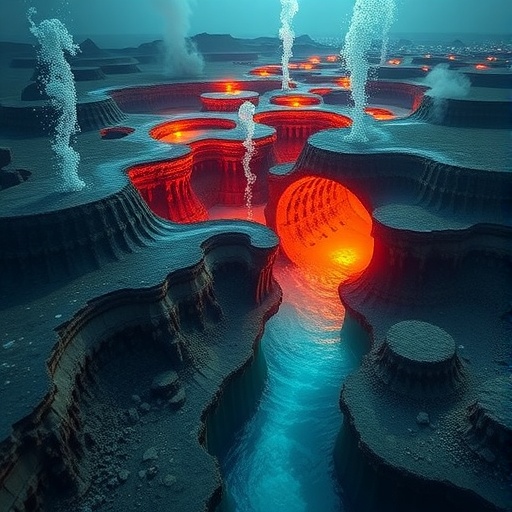In a groundbreaking study published in Commun Earth Environ, researchers have focused their attention on the Quaternary period to explore the notable and somewhat alarming phenomena of deep-thermocline cooling. This research addresses an essential aspect of earth’s climatic evolution that may have far-reaching implications for our understanding of oceanic processes and their potential impact on global climate patterns.
The investigation concentrated on the southern Pacific Ocean, a significant yet often under-researched area in terms of oceanographic studies. During the Quaternary period—a time frame that spans the last 2.6 million years—the earth has undergone substantial climatic variations that have shaped its current state. The researchers, led by John Raddatz and his colleagues, aimed to understand how the mechanisms of tunneling within specific oceanic regions could have accentuated cooling effects during this era.
The concept of thermocline, a distinct layer where temperature changes rapidly, is critical in understanding ocean stratification. Beneath the surface of the ocean lies this layer that plays a crucial role in regulating marine ecosystems. The deep-thermocline is particularly important as it not only affects aquatic life but is also indicative of larger climate dynamics that impact atmospheric conditions. This study highlights the Quaternary deep-thermocline cooling as a phenomenon that could potentially be fueled by intensified oceanic tunneling.
During the study, the authors leveraged advanced oceanographic models that allowed them to simulate past climate scenarios and analyze the resulting temperature gradients. The models cast light on complex interactions between ocean currents, thermal stratification, and geological processes occurring in the southern Pacific region. The research team meticulously mapped out how tunneling affects nutrient distribution and thermal properties of ocean waters.
The findings of Raddatz and his team underscore that the cooling of deep-thermocline waters was not merely a passive phenomenon but rather an active and dynamic process. The southern Pacific Ocean, through tunneling processes—which involve the movement of water masses through geographical constrictions—exhibited heightened levels of cooling during the Quaternary. Such cooling could inadvertently lead to changes in ocean circulation patterns, further influencing climatic zones across the globe.
Environmental implications of these research results extend beyond academic discourse. By establishing that the southern Pacific oceanic processes contributed greatly to cooling, the authors have opened a dialogue regarding the current state of the world’s oceans and how we might respond to arterial shifts in global temperature. Observing this historical cooling trend serves as a crucial reminder of the delicate balance maintained within the earth’s climatic systems that is subject to both natural and anthropogenic influences.
Moreover, the study emphasizes the essential need for continued research to understand past patterns to make informed predictions about future climatic changes. Understanding how oceanic systems have historically responded to cooling events can furnish insights into potential future behavior amidst ongoing climate change scenarios. The authors advocate for increased funding and resources directed toward oceanographic studies, particularly in the southern Pacific region, which they highlight as crucial for comprehensive global climate modeling.
The discourse surrounding the consequences of ocean tunneling and its thermal impacts is vital for scientists and policymakers alike. By shedding light on this specific area, the research complements a body of knowledge that seeks to elucidate the interconnectedness of oceanic and atmospheric climates. It filters into discussions of how socio-economic policies must adapt to the evolving landscape created by climate shifts, as many coastal cities and ecosystems are already feeling the repercussions of rising sea levels and shifts in marine biodiversity.
As further investigations into the Quaternary period unfold, insights from studies like this will likely help shape future academic inquiry. The technological advancements in simulation modeling employed by Raddatz and co-authors set a precedent for future research aimed at uncovering layers of climate history that are intimately attached to both ocean stratigraphy and life on Earth. These studies serve as a bridge, connecting historical weather patterns with predictive models that can aid in adaptive strategy development for climate resilience.
In conclusion, the findings shared by Raddatz and his co-authors represent a significant stride in our understanding of oceanic dynamics during the Quaternary period. As the world grapples with the challenges of climate change, such insights provide a necessary foundation for proactive response measures. The intersection of past oceanic behavior and present-day implications will be a crucial component of future climate action and policy discourse. This research not only heralds a deeper understanding of our planet’s chronological climatic narrative but also stresses the importance of sustainable stewardship of our oceans for the generations to come.
In synthesizing the complexities of oceanographic dynamics and historical climate data, the research invites not just the scientific community but also the public to engage in meaningful discourse regarding our ocean’s future, emphasizing the inextricable link between sea and land, past and present, event and consequence.
Subject of Research: Quaternary deep-thermocline cooling and southern Pacific Ocean tunneling.
Article Title: Quaternary deep-thermocline cooling enhanced by southern Pacific Ocean tunneling.
Article References:
Raddatz, J., Zeeden, C., Kniest, J.F. et al. Quaternary deep-thermocline cooling enhanced by southern Pacific Ocean tunneling. Commun Earth Environ 6, 822 (2025). https://doi.org/10.1038/s43247-025-02886-x
Image Credits: AI Generated
DOI: 10.1038/s43247-025-02886-x
Keywords: Quaternary, thermocline, southern Pacific Ocean, climate change, ocean dynamics, cooling effects.




